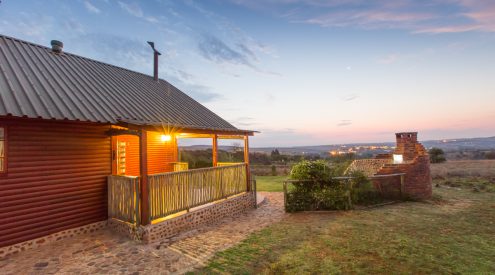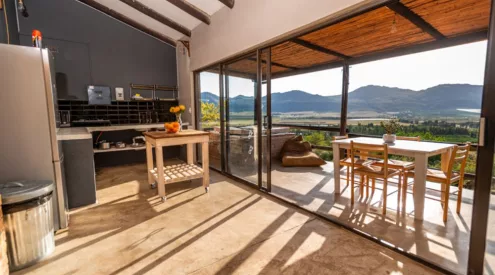Boasting surreal landscapes with brazen, fiery sunsets that frame lone baobabs, breeding herds of elephants grazing on the roadside, mighty rivers and intricate inland wetland systems with papyrus-lined waterways, Botswana is one of the premier wildlife destinations in Africa. Carolynne Higgins picks out five of her top spots for an authentic Botswana safari.

A mekoro ride on Botswana’s Okavango Delta is one of the best ways to explore its wildlife
Whether you take to the semi-arid desert regions of the Kalahari or the fragile salt pans of the Makgadikgadi; the Chobe National Park with its mighty river or the fertile, wildlife-rich Okavango Delta, you’ll be forgiven for thinking you’ve reached Nirvana on a Botswana safari. For first-time visitors to Botswana I recommend traversing your way through the Chobe region, the Okavango Delta and the contrasting Kalahari Desert region. This gives you the best of both a land- and water-based Botswana safari.
The Chobe region and the Okavango Delta: best for a Botswana safari
Chobe is fondly referred to as the ‘Land of Giants’ because of its abundance of elephant herds and is home to the Chobe National Park which has one the highest concentrations of game in Africa. It has a diverse habitat comprising savannah, grasslands and the lush floodplains and marsh areas that form part of the Chobe River. Drive down any road in the Chobe region and you’re bound to spot elephants grazing on the grass embankments.
The Okavango Delta is one of the largest inland wetlands in the world and was nominated as one of the natural wonders of the world in 2013. With over 90 species of fish, 500 species of bird, an abundance of hippo, crocs and predators; the delta is the lifeblood of many species. The Moremi Game Reserve, the many private islands and intricate waterways of the delta system create a magical water safari kingdom giving rise to a spectacle of wildlife.
Our aim of this article is to share a few of Botswana’s hidden secrets. We’ve selected our 4 lodges that offer a sense of authenticity, reflect the humility of Botswana culture and bring in elements of their natural surrounds to their architecture. These lodges are affordable, understated and have moved away from the ostentatious commercial glitz that detracts from Botswana’s beauty.
Stay at your choice of these five great Botswana safari destinations and let this peaceful country of wildlife, culture and landscapes cradle your spirit.
Ghoha Hills Savuti Lodge, Chobe National Park
[youtube http://www.youtube.com/watch?v=HGWWj66_I1s]
Ghoha Hills Savuti Lodge is ideal for the discerning traveller that craves remoteness in a breathtaking setting. Gracefully perched on the ledges of Ghoha Hills in the Chobe National Park, this eco-sensitive lodge offers sweeping views of the landscapes and horizons that go on for miles – the night skies and horizons practically envelope you.
Ghoha Hills is independently owned and is run purely on green, solar energy to ensure minimal impact on the environment. There is an open, main thatched area which houses a dining area, bar and curio shop. Nine, twin-bed suites and two family canvas suites rest comfortably on raised wooden decks on the ledge of the hills. Watch game and observe the activity at the waterhole from your private wooden patio or relax in the central boma area where lamps and lanterns light up the lodge, creating a relaxed and romantic atmosphere. Guests can enjoy daily game drives which take place in Ghoha Hills concession and also on the famous Savuti Channel and marsh.
Getting there
Ghoha Hills is 150 kilometres south west of Kasane and 230 kilometres north east of Maun, making it easily accessible and well-worth the visit.

Photo courtesy of Ghoha Hills Savuti Lodge

Luxury tented room on a wooden platform. Photo courtesy of Ghoha Hills Savuti Lodge

This is where you will spend your evenings – around the campfire overlooking the wilderness. Photo courtesy of Ghoha Hills Savuti Lodge

Clean, comfortable, authentic and modern – this is life at Ghoha Hills Savuti Lodge. Photo courtesy of Ghoha Hills Savuti Lodge

The main thatched area at Ghoha Hills Savuti Lodge. Image courtesy of Ghoha Hills.

Exceptional views from Ghoha Hills Savuti Lodge perched on Ghoha Hills in the Chobe National Park. Photo courtesy of Ghoha Hills Savuti Lodge

Ghoha Hills wildlife jostling for place at the watering hole. Photo courtesy of Ghoha Hills Savuti Lodge
Mapula Lodge – Okavango Delta
[youtube http://www.youtube.com/watch?v=vnnAZTp6qQ0]
Deep in the Okavango Delta in a pristine, unexplored area lies the intimate Mapula Lodge. Situated on a private concession of 12 000 hectares and bordering the world-famous Moremi Game Reserve, Mapula is perfectly situated for a variety of sightings on a Botswana safari. Professional guides will take you out on a traditional mekoro (a wooden dugout canoe) to enjoy a water safari where you will see hippo and crocodile. Coupled with this, guests can enjoy both morning and evening game drives. Lion, leopard and wild dog have been very active in the area and there is prolific birdlife for keen ornithologists.
In terms of accommodation, this uncomplicated, luxury lodge has seven twin rooms, one double room and one family unit. Mapula has been built as an extension of the environment and exquisite hardwood trees and fig trees provide a natural canopy over the lodge. Rooms have been built on wooden stilts which provide a bird’s eye view of the Okavango Delta. Open-air showers and classic zinc bath tubs complete its rustic atmosphere.
Mapula is your answer for simple luxuries. And yes, high tea is served.
Getting there
Mapula Lodge is situated on the banks of the Okavango Delta, with access via Chobe National Park, and is approximately 120 kilometres north of Maun

Spotting one of the big five on a game drive at Mapula Lodge. Photo courtesy of Mapula Lodge.

Honeymooners love Mapula Lodge for its blissfully romantic setting. Photo courtesy of Mapula Lodge.

One of the many incredible views from the rooms at Mapula Lodge. Photo courtesy of Mapula Lodge.

A mekoro is a traditional dugout canoe used for water safaris. An experienced guide, called a ‘poler’, guides the canoe. Photo courtesy of Mapula Lodge.

One of the many waterways in the Okavango Delta – a wildlife paradise. Photo courtesy of Mapula Lodge.

The mekoro’s at Mapula Lodge. Photo courtesy of Mapula Lodge.
Camp Savuti – Chobe National Park
With its five traditional Meru-style tents overlooking the Savuti Channel, Camp Savuti certainly does take advantage of its spectacular surrounds. The Savuti Channel is a geographical phenomenon. Numerous earth tremors affect the area and during 1982 the area dried up. The Savuti source in the Linyanti swamp become blocked, but with the recurrence of tremors in 2010 the channel started to flow again. It is now a water paradise and a massive drawcard of the region is its prominent predator sightings. This is the area where lion prides hunt elephant – you can only imagine the number of documentaries that have been made about this area. This is the Savuti Marsh – a wildlife paradise where daily game drives explore the pristine fringes of the channel and marsh area.
Guests can relax in simple stylish comfort in their canvas tents. Tents overlook the Savuti Channel and the wooden platforms at the entrance of the tents serve as a fantastic game-viewing platform. And if that’s not enough, simply spend time in the quaint lounge area absorbing the latest wildlife novel with a gin and tonic in hand.
Getting there
Camp Savuti is a 20 to 40-minute game drive from the Savuti airstrip in Chobe National Park, making it easily accessible for a Botswana safari.

Botswana’s Camp Savuti is famous for its elephant sightings. Photo courtesy of Camp Savuti.

A typical night on safari at Camp Savuti in Botswana involves a roaring fire which sets the scene for a true African experience. Photo courtesy of Camp Savuti

The Meru-style tents at Camp Savuti are a dream, it’s the only way to camp. Photo courtesy of Camp Savuti.

The lounge, dining and bar area at Camp Savuti. Photo courtesy of Camp Savuti.

Just an average sunset over the marsh at Camp Savuti. Photo courtesy of Camp Savuti.
Camp Linyanti – Chobe National Park
During the November season zebras foal in the Savuti and migrate to Linyanti between February and April. Witnessing a wildlife migration is always a highlight of any safari and this is a major attraction in the area. The Linyanti is a remote, off-the-beaten track wetland oasis ideal for wildlife enthusiasts wanting a remote safari experience. The Linyanti is fed by the flooded Chobe and Kwando rivers and is nestled in the north-west corner of the Chobe National Park.
In conjunction with offering the standard game drives, Camp Linyanti also offers daily boating activities on a fully-kitted boat ideal for navigating the unexplored channels teeming with hippo and crocodile.
Views at this camp are awe-inspiring. Dotted in the distance is Namibia’s Caprivi Strip and vistas of the Linyanti lagoon stretch on for miles into the horizon. Here you will find high concentration of elephant, zebra, giraffe, antelope and a variety of mammals.
Camp Linyanti comprises five elevated, en-suite rounded style tents – the perfect balance between comfortable and luxury. In true safari style there are outdoor showers, wooden platforms and plenty of game viewing areas.
Secluded and off the tourist path, Camp Linyati is just you, the views and wildlife. What more could you want?
Getting there
Camp Linyati is on Botswana’s northern border with Namibia, at the top of Chobe National Park, approximately 230 kilometres north of Maun.

The Camp Linyanti breakfast and viewing deck. Photo courtesy of Camp Linyanti.

The tents at Camp Linyanti have their own wooden decks – perfect for game viewing. Photo courtesy of Camp Linyanti.

The marsh and lagoon in front of Camp Linyati teems with crocodile and hippo. Photo courtesy of Camp Linyanti.

The vehicle used for your daily game drives at Camp Linyanti. Photo courtesy of Camp Linyanti.
Haina Kalahari Lodge – Central Kalahari
[youtube http://www.youtube.com/watch?v=R6ZyxkWDdyg&w=700&h=315]
The Central Kalahari Game Reserve is a semi-arid desert region with low-lying shrubs and home to the famous valley of desolation. Here is where you see cheetah in their natural habitat – running free and wild across the plains of Africa. The Kalahari is also home to the rare black-maned lions and the oryx, which is often depicted on brochures of Africa. Apart from its rather stark and desolate but breathtaking landscape, one of the reasons to visit the Kalahari is to get to know the oldest inhabitants of the area – the Khoi San, who were nomads living off the land. Culturally, the Kalahari is Africa’s gem.
Haina Kalahari Lodge is in the enviable position of being located on the border of the Central Kalahari Game Reserve. Day trips into the reserve, quad bike rides and daily game drives are just of the activities to be enjoyed while staying at Haina. But the one thing that sets Haina apart from its counterparts is its San walking experience. Here you will spend a couple of hours learning the San dialect, how to use plants for medicinal purposes and, at the end of your walk, you may even be treated to a dance.
Six luxury canvas tents and three superior tents are sporadically placed around camp to create a feeling of privacy. The use of natural thatch throughout and wooden decks creates a natural African feel to this four star lodge. A private airstrip is located a five-minute game drive from the lodge and is often used as a spot to have sundowners as a plethora of wildlife surrounds the airstrip.
Getting there
Haina Kalahari Lodge is situated at the top of the Central Kalahari Game Reserve, approximately 260 kilometres south of Maun
This post is brought to you by Sun Destinations, who handle the marketing and reservations for a selection of Africa’s Hidden Secrets. Check out Sun Destinations on Google+ and Sun Safaris on Facebook, Twitter, and Pinterest.

















